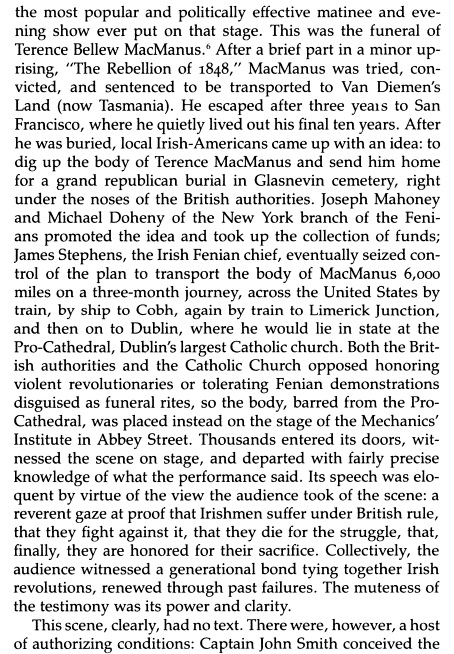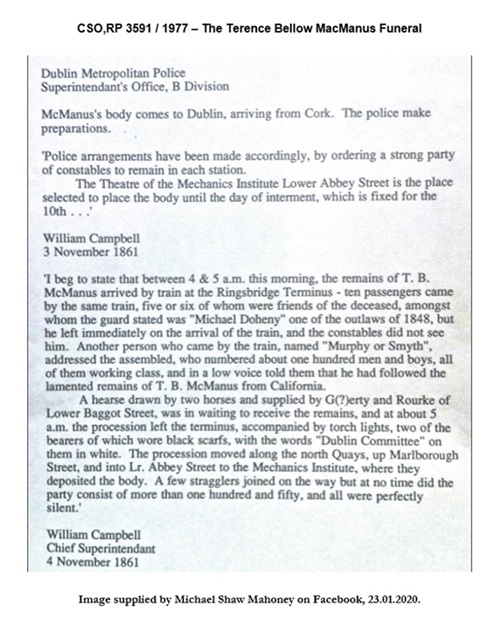Life
1823-1861 [var. 1811]; b. prob. Tempo, Co. Fermanagh; successful shipping agent in Liverpool; joined Young Ireland in about 1843; at Ballingarry with Smith O’Brien and John Blake Dillon; arrested in Cork on board US-bound vessel; death sentence commuted to Van Diemen’s Land for life; settles at Luanceston, called on O’Brien to accept ticket-of-leave; summons and sentenced for visit to O’Brien; escaped with Meagher, 1852; receives Habeas Corpus on non-production of papers of transortation by Denison’s govt. in 1851; attends Meagher’s wedding;
escaped to America under circumstances of extreme hardship (which he described as ‘little short of what you can imagine of hell’s flames’, in a letter to C. G. Duffy), and settled in San Francisco; failed in business as a shipping agent; died in poverty, 15 Jan. 1861; his body brought to Ireland and buried Glasnevin, 10 Nov. 1861, after huge Fenian-organised demonstration-procession of some 70,000, and orations by Col. Smith (speaking words of James Stephens) and Fr. Lavelle; the lying-in-state took place in Mechanics’ Hall, the use of the Pro-Cathedral having been refused by Cardinal Cullen. ODNB DIB DUB
[ top ]
Criticism
Joseph Lee, The Modernisation of Irish Society 1848-1918 (Oxford: Clarendon Press 1973) - quoted here under Cardinal Paul Cullen; also Thomas Keneally, The Great Shame: A Story of the Irish in the Old World and the New (London: Chatto & Windus 1998), passim, and Oliver MacDonagh, States of Mind: A Study of Anglo-Irish Conflict, 1790–1980 (London: George Allen & Unwin, 1983), pp.84–85; Adrian Frazier, Behind the Scenes: Yeats, Horniman, and the Struggle for the Abbey Theatre (Berkeley: California UP 1990),
| Adrian Frazier, Behind the Scenes: Yeats, Horniman, and the Struggle for the Abbey Theatre (Berkeley: California UP 1990): |
|
 ` ` |
|
Frazier goes on to say: ‘The authorship of “The Last Appearance of Terence Bellow MacManus” consists in the Fenians' conception of how the event would be read and on the conspiracy of the Irish masses to read it as meaningful. / Not only did the event have its authorship (organisational and communal), it also had other elements of dramatic performance, such as one actor. MacManus at the time of his death was an unsuccessful San Franciso business man; at the height of his glory, he was only a minor figure in a civil disturbance requiring the attention of the local constabulary. On stage, however, he was cast in the role of a martyred hero. [...]’ (Preface pp.xv-xviii; p.xvii.) |
| —Citing Oliver MacDonagh, States of Mind: A Study of Anglo-Irish Conflict, 1790–1980 (London: George Allen & Unwin, 1983) - which gives an account of MacManus"s reinterrment in Dublin (pp.84–85). |
[ top ]
References
Dictionary of National Biography, gives bio-dates ?1823-1860; member of the ’82 Club, 1844; joined ‘physical force’ movement, 1848; took part in Tipperary civil war [sic], arrested and transported to Van Diemen’s Land, 1849; escaped, 1852, died San Francisco.
Seamus Deane, gen. ed., The Field Day Anthology of Irish Writing (Derry: Field Day 1991), Vol. 2, gives bio-dates 1823-1860; not however that 1861 as death-date cited in the passage from John Devoy (‘Burial of Terence Bellew McManus’, in Recollections) which this bio-date serves to introduce.
Jonathan Bardon, History of Ulster (1992), Terence Bellew MacManus, Fermanagh born veteran of 1848 rising, died in poverty in California after escape from Australian penal servitude; lying in state in St Patrick’s Cathedral, NY; followed by 30,000 to Glasnevin, where a torchlit oration was made by James Stephens [see also Fr. Patrick Lavelle].
[ top ]
Notes
On bio-dates: ODNB gives bio-dates ?1823-1860; FDA 1823-1860, but note var. ob. 1861 in Intro. to ‘Burial of Terence Bellew McManus’; DIB & DIH both give 1811-1861.

|
| Click image to enlarge in separate window |
[ top ]